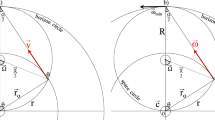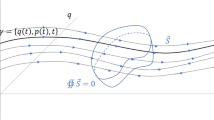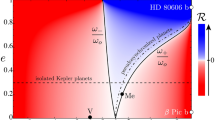The poet's vividly imagined flight unwittingly captures a physical law of motion.
Abstract
In 1632, Galileo described his experience of motion aboard a large ship1,2 and exposed in detail the invariance principle, which was then rightly named after him. I suggest that more than three centuries earlier, in The Divine Comedy, his fellow countryman Dante Alighieri intuitively grasped what Galileo was later to establish as one of the pillars of modern science.
Similar content being viewed by others
Main
The Divine Comedy narrates Dante's journey through the hereafter. A remarkable feature of this masterpiece is the vividness of the narration: it is a work of fiction brought to life by the realistic detail. One part deals with Dante's descent from the seventh to the eighth circle, recounted in canto XVII of the Inferno. Up to this point, the pilgrim Dante had travelled on foot and occasionally by other means (for example, on Phlegyas' boat, in canto VIII, and on the back of the centaur Nessus, in canto XII).
However, the steepness of the bank between the two circles makes descent possible only by flying — in this case on the back of the monster Geryon. Dante himself reminds us that he is not the first, mythologically speaking, to have flown: Phaeton and Icarus had done it before him. But he is probably one of the first to describe the actual sensation of flying, which he does with an accuracy that is evidence of his extraordinary imagination, as noted by several commentators3.
Sitting on Geryon's back, Dante describes the initial motion of the infernal monster by comparing it to “a little vessel [that] shoves from shore”. Geryon then turns and leaves the circle rim, causing Dante to lose his points of visual reference: “I perceived myself / On all sides in the air, and saw extinguished / The sight of everything but of the monster”. Then (lines 115–117, written around 1310 and translated by Henry Longfellow in 1867 (ref. 4)): “Onward he goeth, swimming slowly, slowly / Wheels and descends, but I perceive it only / By wind upon my face and from below.”

These three lines are a typical example of Dante's ability to summarize several concepts and to describe complex situations in simple statements of a few words. In spite of its apparent simplicity, the tercet reveals some remarkable physical intuition. First, the observer Dante can imagine himself in a frame that a contemporary physicist would define, with fair approximation, as inertial. Although the monster is wheeling, its motion occurs “slowly, slowly” while obeying Virgil's command “Now, Geryon, bestir thyself; / The circles large, and the descent be little”. So the flight path corresponds to a wide, slowly sinking spiral and is travelled smoothly (“swimming”), or, a physicist would say, almost uniformly.
At the bottom, the monster sets the poet down close to the wall, so the flight path may be assumed to have a diameter similar to that of the cylindrical “abyss”. This was estimated by, among others, Galileo5 to be 35 Italian miles wide, or about 60 km: this value relies on two precise indications, given in canto XXIX, line 9 and canto XXX, lines 86–87, respectively (which also suggest that Dante was aware of the approximation π≈22/7).
A contemporary physicist could show that, given such dimensions and whatever the speed, the fictitious centrifugal force experienced by the passenger would be much smaller than the surface force due to the apparent wind: no such force is mentioned in the text. Although such a derivation would have been beyond the knowledge of physics in the Middle Ages, Dante did understand how his motion occurred seemingly in a straight line: he indicates its direction, by decomposing the vector describing the apparent wind in terms of its horizontal (“upon my face”) and vertical (“from below”) components.
Now comes the crucial point. With regard to the motion experienced on the flying monster, in the original tercet Dante says “ma non me ne accorgo”: he is not aware (or, more accurately, he imagines that he is not aware) of anything but the apparent wind. Dante asserts that, aside from the effect of the wind, his sensation of flying was not dissimilar from being at rest. From a physical point of view, this ‘invariance’ is in agreement with the concept expressed by Galileo some three hundred years later. In Galileo's work, the invariance is explicitly related to observations and experimental results. But sitting on the monster's back, Dante could not do much better than rely on and consider his own sensory perceptions.
It is difficult to argue that this descriptive accuracy is accidental. Dante intentionally devised a journey, setting up different scenes and situations to express his message directly or allegorically. His imagined experience of flight is the core of this part of the narration, with the entire scene and landscape being created as a stage for its description. In this instance he seems to avoid allegory, perhaps to allow for a more factual, physical interpretation of the text.
Dante intuitively grasped the concept of invariance but, unlike Galileo, he did not pursue this idea any further. Still, it seems that he was well ahead of his time with regard to the views about the laws of nature held in the Middle Ages.
References
Galilei, G. Dialogo Sopra i Due Massimi Sistemi del Mondo Tolemaico e Copernicano (Giulio Einaudi Editore, Torino, 1970).
Galilei, G. Dialogue Concerning the Two Chief World Systems, Ptolemaic and Copernican (transl. Drake, S.; University of California Press, Berkeley, 1953).
Alighieri, D. La Divina Commedia (comm. Sapegno, N.; La Nuova Italia Editrice, Firenze, 1982).
Alighieri, D. The Inferno (transl. Longfellow, H. W.; Barnes & Noble Classics, New York, 2003).
Galilei, G. Due lezioni all'Accademia Fiorentina circa la figura, sito e grandezza dell'Inferno di Dante in Le Opere di Galileo Galilei (Giunti Barbera, Firenze, 1968).
Author information
Authors and Affiliations
Corresponding author
Ethics declarations
Competing interests
The author declares no competing financial interests.
Rights and permissions
About this article
Cite this article
Ricci, L. Dante's insight into galilean invariance. Nature 434, 717 (2005). https://doi.org/10.1038/434717a
Published:
Issue Date:
DOI: https://doi.org/10.1038/434717a
Comments
By submitting a comment you agree to abide by our Terms and Community Guidelines. If you find something abusive or that does not comply with our terms or guidelines please flag it as inappropriate.



